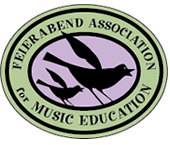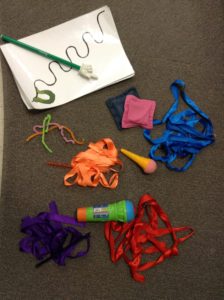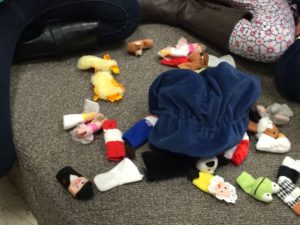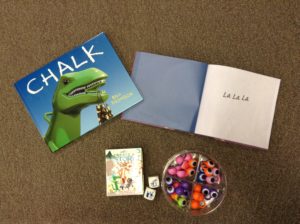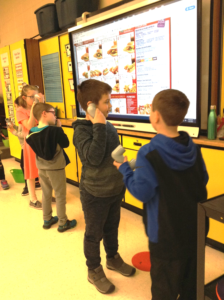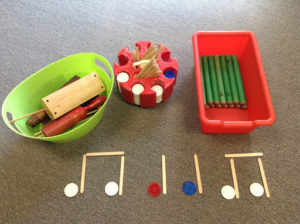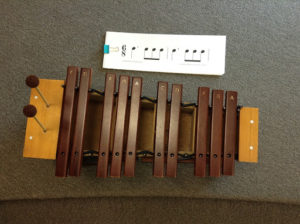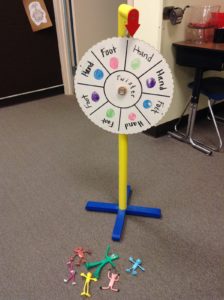Getting Started with Learning Centers Utilizing the Feierabend Approach
Emily Maurek, FAME Teacher Trainer
As the weather turns and holiday breaks approach it is sometimes a challenge to keep students focused and engaged — especially with concerts, parties, schedule changes, and more! Combat the craziness with learning centers for ALL age levels! Self-directed learning is a great way to wrap up a semester/calendar year with culminating activities that can also provide a chance for last-minute assessments when report cards are due. Open those cabinets, hit the dollar store, and you can assemble a few life-saving activities to guide you through the weeks before the holiday break with ease and hopefully, sanity.
Prepping Your Centers and Routines
Start with numbers. Imagine your largest class and then divide into a manageable number. That is your starting point for planning. For me, my largest class is currently 28 (third and fourth grade) so having 4 centers of 7 each is at the top of my tolerance level. If 5 or 6 in a group is more your style, add another activity/center (IPads? Whiteboards?)
Next, allow around 10 minutes per center for older kids, 6-7 minutes for the youngest. In 45-minutes I can finish all centers in one period. For some they may spill over into the next class meeting (which may be a good thing and more bang for your buck). Factor time needed into your planning — your students will want to fully experience ALL of the activities in each center and not feel they’ve missed something.
Demonstrate each center to the class so they understand expectations. Create and review a quick list of rules for centers: clean up before rotating, take turns, raise hands for help, inside voice, etc. to ensure student success.
Have a plan for how students will travel and rotate to each center. My students know they rotate as a group, not individuals. When time is up, I use a wind chime as a signal to tell students to clean up and sit down while waiting until their group rotates. Before rotating I also have students count all of the items in a station to make sure none are lost or hiding.
Grade K-2 Learning Centers
Creativity is the only limit to planning center content. I steer toward activities that provide individual attempts and chances to create musically — alone and with others. Here is a sample of the four centers I use for grades Kindergarten through Second Grade:
Center #1: Pitch Exploration
I love to dump out my pitch exploration toy bin, lay out the Pitch Exploration Pathways and Stories cards, and let the kids have fun! Kids are not always the leaders of pitch exploration in a normal class setting but in this center they lead everything! They particularly love the ribbons on a stick, beanbags, and the teacher microphone and pointer. I know these kids are on task when I hear their voices match their movements. I can also “play” with individuals to encourage and achieve use of the lengthening muscles. Reluctant students can be more willing to vocalize when they know they are not the center of attention. This center can usually direct itself though I do like to stroll by to confirm students are utilizing a high, light sound.
Center #2: Puppet Stadium
Pile up the puppets and allow the kids creative space. Though I encourage students to make the sounds of the puppet they choose, I like to throw in new and unconventional options (scuba diver? giraffe?) to see what they do. Some students choose to sing songs about the puppets, some adapt familiar songs into new ones, and others are quite literal — the frog puppet equals Frog in the Meadow. IKEA is a great source for random puppets and Folkmanis makes very durable and detailed animals.
Center #3: Ariosoland
This center is completely devoted to original text and tune. All I provide are pictorial suggestions, “eyeball” rings and the students take it to the next level and beyond. Students may choose to work alone, others in partners or small groups. I tend to hover around this center because I’ll sometimes get responses I don’t always have the pleasure of hearing in class. The more reluctant singers are more apt to try in this safe space. Picture books without words, Rory’s Story Cubes, and my new favorite, Create-a-Story Cards are all great resources.
Center #4: Drive-Thru Restaurant
Hungry for lunch? The idea for this center came from the Feierabend Fundamentals Facebook page years ago and it’s been a hit in my classroom since. Project a popular fast-food menu on the screen, add imagination, and you have a drive-thru restaurant! I purchased some Whisperphones into which students can sing their orders to themselves or the “order taker”. The students then switch roles of customer and worker, all the while singing what they would like to say.
Older Students and Centers
After enjoying learning centers in the earlier grades my third and fourth graders inspired me to come up with activities for their age level. Since I utilize Conversational Solfege with these grade levels it was a natural fit to incorporate CS activities students could do independently. Centers for older kids can cover a lot of ground — reading and writing steps of a current unit and past objectives can easily be achieved. I try to plan centers for older students with instruments and without to manage excess sound. My next-door neighbor teacher appreciates this very much. Here are my picks:
Center #1: Poker Chips/Craft Sticks
In this photo my kiddos were reviewing Unit 1 Step 12 Writing: Create as a past objective by creating and writing a four-beat pattern and playing it on an instrument. Students kept busy by playing each others’ patterns, making multiple four-beat patterns, and trading instruments. You could also have students practice Step 9: Writing: Rote with their sticks and chips, copying patterns of your choosing from flashcards or SmartBoard. Encourage students to always say their patterns before writing them.
Center #2: Partner Xylophones
To reinforce Unit 4 Step 5: Conversational Solfege: Create (Do Re Mi) and Unit 2 Step 6 Reading: Decode Familiar I put out my laminated Unit 2A flashcards and set up several xylophones, F=Do. Each pair of partners had to create a DRM pattern using the rhythm shown on the flashcard.
To play patterns, students follow this procedure: 1. Sing with pitch syllables and appropriate rhythm 2. Touch the bars while singing again using letter names 3. Finally, play the pattern. Then the partners switched roles, allowing the other to sing and play.
Another possibility is to play by color and assign pitches to corresponding colors. For this I utilized the rhythm cards in the back of Conversational Solfege Book 1 and copied onto three colors of paper. I also created a step-by-step instruction sheet and placed a big stack of the colored rhythm cards nearby.
Center #3: Movement Exploration
This could easily work for younger and older children alike but I chose to throw this one to the oldest because they can do the activity independently with no adult. There are two “games” here. One is a twist on the game Vertical Twister (Laban Theme 4: Awareness of Levels) from the Book of Movement Exploration. I customized a spinner wheel (a Twister board game spinner would also work here) and participants place the various parts of the body in different levels. The second game is “Gumby”. Children can divide into pairs or work alone and manipulate the stretchy characters into body shapes to copy.
Center #4: Pitch Exploration/Arioso/Drive-Thru Restaurant
So even my older students like to play like they did when they were younger and I’ll mash-up two of the centers from the Kindergarten to Grade 2 years — Pitch Exploration and Arioso. The older students particularly enjoy the drive-thru restaurant, puppets and the pitch exploration toys. It’s fun to watch them enjoy those activities all over again.
Assessment
Though performing formal assessments at centers is not a necessity, it can be an efficient and lower-pressure option to gain views of a students’ musical progress. Pick one center and make that your assessment stop — formal or informal. For younger students that could be a pitch exploration center demonstrating vocal glissandi or CS reading/writing stations for older students. With students who struggle to be tuneful, circulate the room and catch them at several stations to reinforce concepts with them individually. At writing centers, using manipulatives, white boards, or Ipads to write notation can be fun and less intimidating than traditional paper and pencil. I also use center time as a way to check in with students who may be new to our school, those who really love to be the “star”, and kiddos who need a little extra attention.
Conclusion
During the holidays students are quite capable of being competent musicians despite the holiday buzz and excitement. With centers there’s something so valuable about breaking routine and allowing a little exploration. Centers also provide a chance to differentiate instruction and an opportunity to connect with kiddos who could use some one-on-one time with the teacher. I find even the most inhibited students will make a greater effort in a smaller group or off to the side amidst the controlled chaos and noise of small groups. It’s a fabulous chance to encourage a child to access that higher/lighter voice, invite solo attempts, or create conversationally. Sprinkle a few centers into your teaching and enjoy the results this holiday season, or any time!
For more learning center inspiration search the Feierabend Fundamentals page on Facebook and connect with others who utilize this approach with their students. And many thanks to those on the page who have inspired me! Happy planning!
